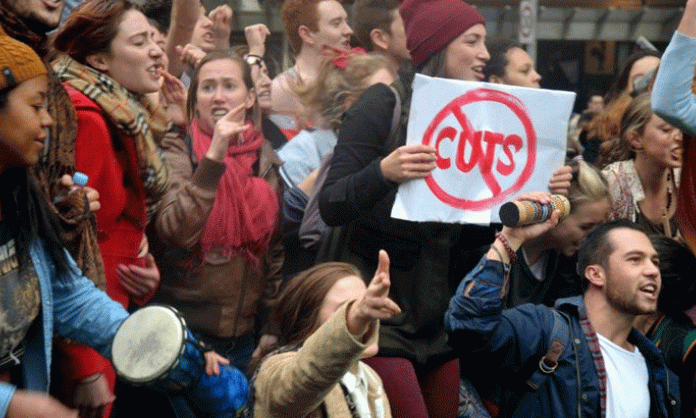In response to government cutbacks to higher education announced in April, students initiated an anti-cuts campaign that on 14 May mobilised the biggest student protest in years in Melbourne, where 3000 joined the central demonstration. In Perth, 700 students protested at Curtin University. This is remarkable for one campus by any standards, but is particularly significant at Curtin, which doesn’t have a reputation for student radicalism.
The success of these rallies, called by the National Union of Students (NUS), indicates it is possible to build a serious campaign against the cuts.
But there are serious discussions to be had about how to build this new movement. Outside of Melbourne and Curtin, the 14 May mobilisations were much smaller. At the University of Western Australia only 50 students joined the protest. In Sydney, a city with an equivalent student population to Melbourne, only 300 students took park in the central demonstration.
Where activists and students unions threw their weight behind protests, they were sizeable; where they didn’t, the turnout was much smaller.
Some students within the movement have argued that protests are old-fashioned and even counterproductive. They argue that protest does not work and alienates people. These tired, conservative arguments have been around for decades.
The reality is that the protests have already played a positive role in increasing support for the student campaign. Before the 14 May demonstrations, political analysts asserted that the education cuts would not affect the federal election; they are now being discussed as a key factor. This is similar, on a smaller scale, to the way the equal love campaign put equal marriage on the political agenda.
There are plenty of examples from around the world of how effective student protests can be. Most recently in Quebec, students forced the government to repeal its plan to increase tuition fees as well as forcing the government to repeal a law restricting protests.
In Australia, the few wins we have had in holding back the tide of cutbacks and neoliberal attacks on universities have come when students hit the streets in protest. For example, when Paul Keating tried to introduce HECS increases in 1995, NUS called protests that brought more than 15,000 students onto the streets. The government very quickly scrapped its plans.
Whenever the student movement has turned away from protests towards more conservative tactics, it has been a disaster. When HECS was introduced in 1989, just two years after the formation of NUS, the union failed to organise any protest campaign. Instead, it launched a High Court challenge to the constitutionality of HECS. The government, predictably, saw no need to take NUS seriously.
In the 1990s Victorian students mobilised successfully to stop the implementation of voluntary student unionism (VSU) by the state Liberal government. In 2005, when the federal Liberal government announced VSU across the board, there was a series of sizeable demonstrations around the country. Unfortunately, by the end of the year, Labor students had shifted the focus of the campaign in a “Vote Labor” direction. In the absence of ongoing public pressure from students, Howard was able to steamroll his legislation through.
We need to build on the successes so far in this new campaign and organise big central street demonstrations for semester two, as well as focus on building campus and state collectives to engage more students. At all levels, the campaign has to maintain a focus on the national and central actions to apply any effective pressure on the government.
We also need to respond to the cuts as they are implemented by individual university administrations. Vice-chancellors may have come out against the cuts, but they have also been leading the charge to open up universities to the market. Management may not like smaller budgets, but they will have no qualms about cutting staff and courses.
To rebuild the movement, students need to engage with student unions. Some in the student movement have been arguing for NUS to be sidelined and even boycotted. That would be counterproductive. There is no other institution that can claim to represent such a large number of students, that can coordinate things on a national scale and that can resource a serious campaign.
It is true that most student unions have entrenched anti-democratic and bureaucratic structures and remain the domain of careerist student politicians. But these are reasons to fight for our unions rather than abandon them.
The next national protest will happen early in semester two and is a chance to get thousands of students onto the streets again. The cuts still have to be discussed in parliament, probably in late September, and then passed into law. This is an opportunity to put some pressure on the incoming government.
Student union elections will also take place towards the end of semester two. Left-wing students who are against the cuts need to organise together to fight for student unions that are made up of activists who want to fight the cuts and push the union in a more progressive direction on other fronts too.
Left wing student activists need to work together over the holidays to plan campaign events and discuss strategy and tactics. The NUS Education Conference in Adelaide in July is an opportunity to make this happen.









